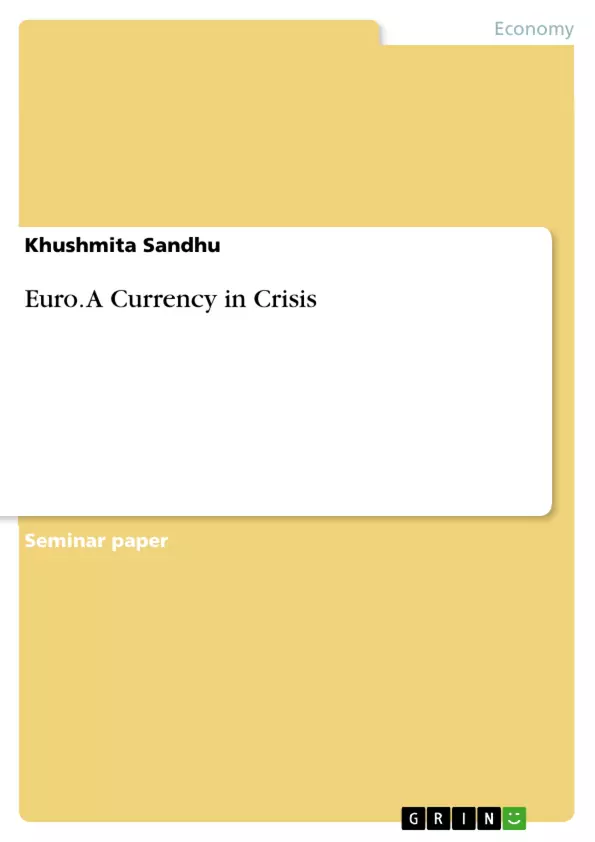Euro, the common currency of European Union, was launched by 11 of the 15 members of the Union, on January 1, 1999. The Maastricht treaty of 1991, which set the stage for the monetary union, laid down certain eligibility criteria for member countries to join European Monetary Union (EMU), such as maintaining budget deficit, public debt, inflation, long term interest rates and exchange rate within defined limits . The Euro was introduced to world financial markets as an accounting currency on 1 January 1999, replacing the former European Currency Unit (ECU) at a ratio of 1:1 (US $ 1.1743). Euro Coins and Banknotes entered circulation on 1 January 2002 .
While the Euro dropped subsequently to US $ 0.8252 within 2 years (26/10/2000), it has traded above the US $ 1.5990 on July 15, 2008 . Since late 2009, the Euro has been immersed in the European Sovereign Debt Union Crisis which has led to the creation of ‘European Financial Stability Facility’ as well as other reforms aimed at stabilizing the currency. In July 2012, the euro fell below US $1.21 for the first time in two years, following concerns raised over Greek debt and Spain’s troubled banking Sector. As of June 2012 with more than Euro 906 billion in circulation, the euro has the highest combined value of bank notes and coins in circulation in the world, having surpassed the US $. Based on International Monetary Fund estimates of 2008 GDP and purchasing power parity among the various currencies, the Euro Zone is the second largest economy in the world.
The countries whose currencies are in Euro are known as Euro land. In this background, the present term paper will try to explore the emergence, ascent and recent problems being faced by Euro zone. Specifically the objectives of the present study are: To explore the emergence of Euro; to analyse the recent crisis in Euro.
Inhaltsverzeichnis (Table of Contents)
- INTRODUCTION
- EMERGENCE OF EUROZONE
- BENEFITS OF EURO
- EURO V/S DOLLAR
- EUROZONE CRISIS
- IMPACT OF EUROZONE CRISIS ON INDIA
- CONCLUSION
Zielsetzung und Themenschwerpunkte (Objectives and Key Themes)
This term paper aims to explore the emergence, rise, and recent challenges faced by the Eurozone. Specifically, it focuses on the emergence of the Euro and the recent Euro crisis. The paper analyzes the factors contributing to the Eurozone's creation and investigates the causes and consequences of the current financial crisis impacting the Euro. Key themes and ideas explored include:- The history and evolution of the Eurozone, including the role of the Bretton Woods system
- The benefits and drawbacks of adopting a single currency
- The causes and consequences of the Eurozone crisis
- The impact of the crisis on various countries, including India
- Potential solutions and reforms to address the Eurozone crisis
Zusammenfassung der Kapitel (Chapter Summaries)
- INTRODUCTION: The introduction provides an overview of the Euro, its historical context, and its significance as a global currency. It highlights the Euro's origins, its initial introduction, and the subsequent fluctuations in its value against the US dollar. It also mentions the ongoing European Sovereign Debt Union Crisis and the measures taken to stabilize the Euro.
- EMERGENCE OF EUROZONE: This chapter delves into the historical context of the Euro's emergence, tracing its roots back to the Gold Standard era. It discusses the evolution of international monetary systems, including the Bretton Woods system and its subsequent collapse. The chapter then explores the creation of the European Monetary System (EMS) and the European Currency Unit (ECU) as precursors to the Euro. Finally, it examines the Maastricht Treaty of 1991, which laid the groundwork for the establishment of the Eurozone.
- BENEFITS OF EURO: This chapter, likely focusing on the positive aspects of the Euro, may discuss the economic and political advantages of a single currency. These might include reduced transaction costs, increased trade and investment within the Eurozone, and enhanced economic integration.
- EURO V/S DOLLAR: This chapter likely explores the relationship between the Euro and the US dollar, examining their relative strengths and weaknesses. It might delve into the factors influencing the exchange rate between the two currencies, such as economic performance, interest rates, and political events. It may also discuss the rivalry between the Euro and the US dollar as global reserve currencies.
- EUROZONE CRISIS: This chapter focuses on the current Eurozone crisis, analyzing its causes and consequences. It might examine the role of government debt, banking sector vulnerabilities, and the lack of fiscal coordination among member states in contributing to the crisis. The chapter may also discuss the various measures implemented to address the crisis, including bailouts, austerity programs, and structural reforms.
- IMPACT OF EUROZONE CRISIS ON INDIA: This chapter explores the impact of the Eurozone crisis on India's economy. It might discuss the potential effects on trade, investment, and remittances from the Eurozone. It may also examine the implications for India's currency and financial markets.
Schlüsselwörter (Keywords)
The central keywords and focus topics of this term paper include the Euro, the Eurozone, the European Monetary Union (EMU), the Bretton Woods system, the European Monetary System (EMS), the European Currency Unit (ECU), the Maastricht Treaty, the Eurozone crisis, sovereign debt, banking sector, fiscal coordination, austerity programs, structural reforms, and the impact of the Eurozone crisis on India.- Quote paper
- Khushmita Sandhu (Author), 2012, Euro. A Currency in Crisis, Munich, GRIN Verlag, https://www.grin.com/document/281636



